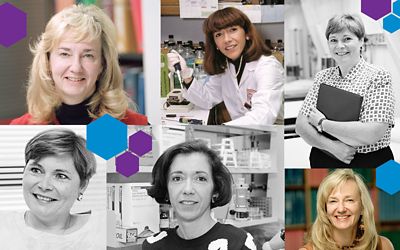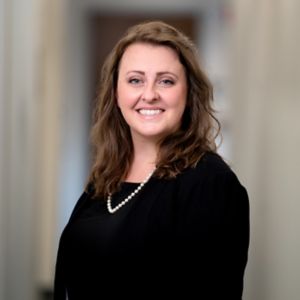St. Jude Family of Websites
Explore our cutting edge research, world-class patient care, career opportunities and more.
St. Jude Children's Research Hospital Home

- Fundraising
St. Jude Family of Websites
Explore our cutting edge research, world-class patient care, career opportunities and more.
St. Jude Children's Research Hospital Home

- Fundraising
Celebrating women’s mentorship: Stories from St. Jude luminaries

Celebrate women in science with advice from Martine Roussel, PhD; Patricia Flynn, MD; and Elaine Tuomanen, MD, St. Jude luminaries who have led research for decades.
As he set out to fight the Trojan War, Odysseus, the king of Ithaca, needed a guide and educator for his son Telemachus. He turned to a trusted friend: Mentor. Over time, the character of Mentor has become synonymous with the concept of mentorship — a definable, collaborative and dynamic relationship between a teacher and a student. In science and medicine, a mentor’s role extends beyond teaching. For early-career researchers and clinicians, finding the right mentor means finding a coach, an advocate, and even a family.
Women, as a group, have long been underrepresented in science and still face barriers. Recent societal shifts and the hard work of individuals and groups to make science a welcoming place mean trends are beginning to move in the right direction. Many women who became scientists decades ago, however, had to battle to get to where they stand today. With bruises on their shoulders, these women have carried the weight of creating space for the next generation of investigators and scientific leaders.
At St. Jude, Elaine Tuomanen, MD, former St. Jude Department of Infectious Disease chair; Patricia Flynn, MD, St. Jude Department of Infectious Disease; and Martine Roussel, PhD, St. Jude Department of Tumor Cell Biology continue to serve as mentors — to both women and men — shaping the future of the fields to which they have contributed so much. Yet, each of these phenomenal scientists has a different story, with different lessons, to share.
Tuomanen: Be Brave.
As a pediatric infectious disease fellow, Tuomanen could run an intensive care unit, but she had never used a pipette. At that time, medicine and research were mutually exclusive training grounds. Motivated and brave enough to explore life at the bench, Tuomanen “broke the rules” and pursued a position in a microbiology lab at Rockefeller University. There, she realized her medical perspective had value — she found a place to build bridges with colleagues to better understand infectious disease. When Nobel laureate David Baltimore, PhD, was named President of Rockefeller, he gave the ultimate gift of mentorship to Tuomanen:
“He gave me a chance to have my own lab, and I’ll never forget it. It was hard for him; he had to be willing to take a chance on me and invest in my path forward. I walk around proudly with a patch on my shoulder that says, ‘I’m a Baltimore kid.’”

Elaine Tuomanen, MD, (left), Virginijus Šikšnys Emmanuelle Charpentier, PhD, (center) and Iselin Nybø together at the 2018 Kavli Prize reception where Charpentier was honored. Photo credit: Thomas Eckhoff.
In many ways, Baltimore was ahead of his time, and with a change in leadership came Tuomanen’s realization that it was time to find a new home. When she arrived at St. Jude, she knew she’d found it. But she didn’t come to St. Jude alone; a trainee from her lab transitioned to St. Jude with her.
“Emmanuelle is a person of great bravery and energy. From the time she walked through the doors at St. Jude, she realized that just doing the science was only a small part of the picture you could imagine drawing.”
At the time, Emmanuelle Charpentier, PhD, now a director at the Max Planck Institute for Infection Biology, was still a postdoctoral researcher. She became devoted to making a difference for the kids at St. Jude. Tuomanen maintains that Charpentier’s drive to pursue the clinical application of biological discovery belongs to the environment cultivated by St. Jude. Charpentier would ultimately leverage her understanding of mechanisms of bacterial resistance to develop a method for genome editing, kickstarting the CRISPR revolution. In 2020, Charpentier became a Nobel laureate herself, winning the Nobel Prize in Chemistry — a proud moment for her mentor, Tuomanen.
“She always wanted a family but never started one of her own. She has been invited to receive countless honors, with family as guests. When she goes to receive all these prizes, she brings me. I don’t know, as a mentor, if there is a greater honor.”
Flynn: Build Bridges.
When Patricia Flynn began her faculty career at St. Jude, human immunodeficiency virus (HIV) was a brand new and poorly understood pathogen. Flynn was part of a new team focused on HIV infection in the St. Jude Department of Infectious Disease led by the esteemed Walter Hughes, MD. Hughes had long studied Pneumocystis jirovecii, the fungus responsible for causing Pneumocystis pneumonia, in the context of childhood leukemia. Observing that most deaths among patients with HIV/AIDs were caused by Pneumocystis pneumonia, Hughes saw an opportunity to translate work in pediatric cancer to the adult population.

Pat Flynn, MD, (left) worked with her mentor Walter Hughes, MD, (center) on HIV/AIDS clinical trials.
“Walter had strong, established relationships with physicians, in infectious disease and otherwise, that studied this particular organism. He was extremely effective at making connections across organizations with HIV programs and instrumental in building bridges between leaders.” Flynn recalls. “Without many of the connections Walter helped me make, especially in National Institutes of Health networks, my career would not be where it is today.”
In clinical research, Flynn asserts that connections are critical for success. Collaborations and relationships help foster the development of projects that move the field forward. For Flynn, chemistry is essential in biology. When considering potential trainees, she focuses on where interests and communication styles overlap. Different people require different things out of a mentoring relationship, and Flynn is thoughtful in considering how the information she shares aligns with a mentee’s needs.
“When I mentor other individuals, I try to reflect the behavior I learned from my early mentors. Learning the science of what you do is incredibly important. But learning how to present yourself as a scientist, collaborator and coach for the next generation is just as critical.”
Roussel: Embrace the Journey.
Martine Roussel spent much of her childhood in Africa, where she developed a fascination for ecosystems and a desire to study animal behavior. Today, she is celebrated as a trailblazer whose discoveries have shaped our understanding of cell cycle regulation and tumor cell biology. Roussel’s journey from Sub-Saharan Africa to St. Jude via her training in France and the National Cancer Institute was guided, in large part, by her mentors.
A leading hematologist, a National Cancer Institute Director, and two St. Jude department chairs all shaped Roussel’s development: from suggesting she shift her studies to genetics and biochemistry to recommending training in public speaking to working in partnership with her husband Charles Sherr, MD, PhD, Department of Tumor Cell Biology on the cell cycle and proposing she map all known cell cycle regulators in the developing brain.
“It wasn’t a single person, but a network of mentors along the way who provided ideas and recommendations. Importantly, I was receptive to those suggestions. The people you encounter along the way shape you — for better or worse — and so you take the pieces that work and build your own approach to mentoring,” says Roussel.

Jennifer Stripay, PhD, (left) and her post-doc mentor Martine Roussel, PhD, (right).
To Roussel, mentoring means shepherding a trainee on their career journey to achieve what is often a very personal objective. As an early advocate of the St. Jude Women in Leadership program, Roussel has developed relationships with young female investigators from the lab and the clinic. She believes it is critical to impart her guidance authentically, showing vulnerability when appropriate and developing a deep understanding of their personal challenges and goals.
In 2016, Roussel sat at dinner with a prospective trainee. Ambitious, excited and skeptical of a postdoctoral role, the trainee shared her dream of leveraging her scientific training to lead a team that shaped and shared stories of biomedical discovery.
“That’s an excellent goal. But I think you need more seasoning as a scientist before you can achieve real success in a role like the one you’re describing. Come train as a postdoc in my lab, and together, we’ll create the path to get you there,” Roussel proposed.
Roussel and I laughed as we reflected on that dinner together — because seven years later, I now sit in the very role I described, thanks in large part to her role as my Mentor and trusted friend.
Valuable lessons
Forging a new path is always challenging, whether it is simply new to you or has truly never been attempted before. For Elaine Tuomanen, Patricia Flynn and Martine Roussel, they built their careers by breaking scientific paths that other women before them had rarely walked. In doing so, they have opened up a world of discovery for the scientists who have traveled those roads since — postdocs and graduate students who come marveling at the newness of their own experiences along the way.
Their advice and their approach to mentorship continue to be a bright light for new scientists coming to train at St. Jude. Be brave. Build bridges. Embrace the journey.






